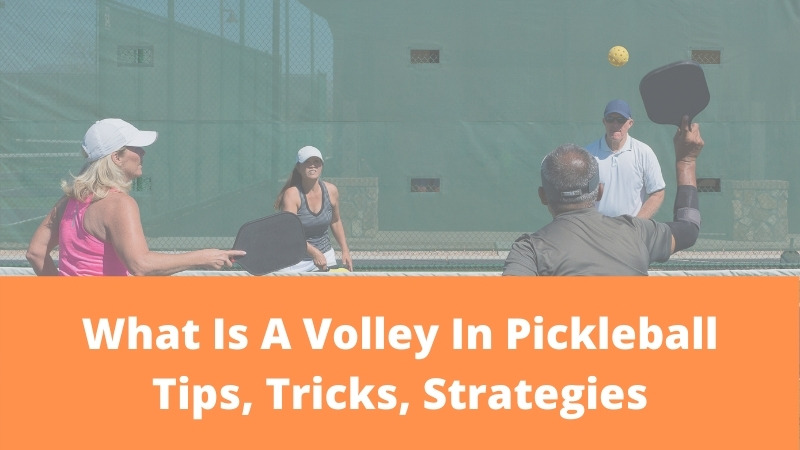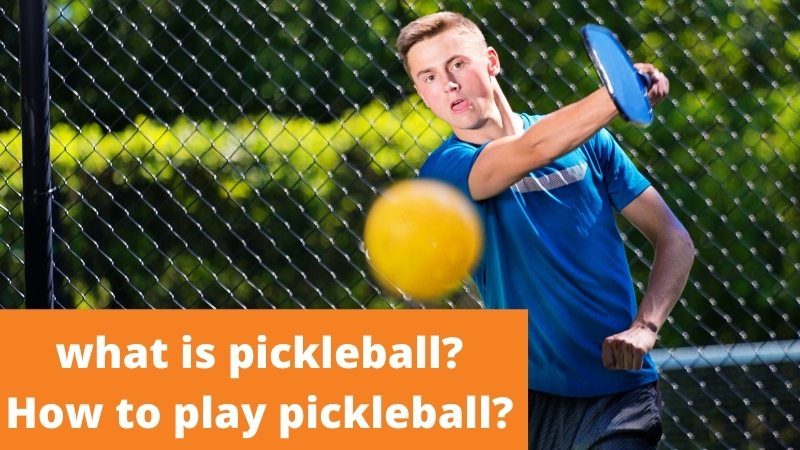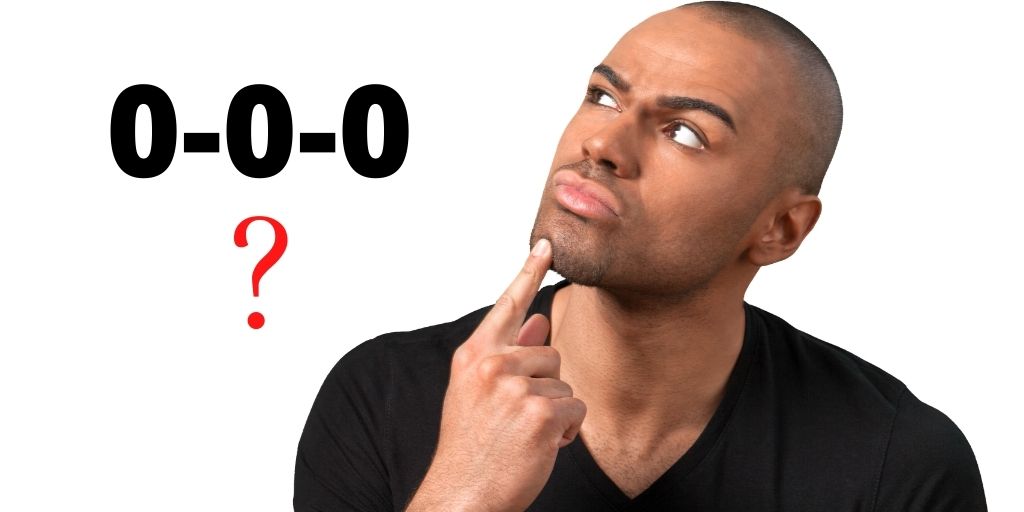Pickleball boasts a vast repertoire of effective shots, just like other racquet sports. However, a volley is one of the essential shots in pickleball. A crisp punch volley is one of the most satisfying shots in pickleball.
Whether you lose or win a match depends on your pickleball volley ability. So, what is a volley in pickleball? Volleying is an action performed at the net that prevents a ball from bouncing. A shot is generally rifled from one end to the other in a quick back and forth movement that lasts only a short time.

What Is A Volley In Pickleball?
During pickleball, a volley means striking balls out of the air before they bounce. The non-volley line is usually the place where volleys are played. Or, the transition area is perhaps where you play them as you start at the baseline and make your way to the non-volley line.
Basics of Volleys
- As a ball bounces onto the court during a rally, it is hit in the air.
- The ball hit low and hard over the net is often returned to the net at the NVZ line.
- Usually hits with a backhand, but the forehand can also be used.
- No backswing; the paddle face must remain vertical (square) when “pushing” the ball over the net.
- Hit far from your opponent to avoid being reached.
- The paddle face slightly can be opened to give the ball more loft when hitting a volley.
What Makes Pickleball’s Volley So Important?
Plenty of points can be won by using the volley technique in pickleball. You can win or lose important points depending on how well you volley during pickleball, and your technique can change the outcome.
Apart from forehand and backhand, many other shots exist in tennis, such as cross court, side spin, dropshot, flat, topspin, slice, block, and so forth. On the other hand, the number of shots in pickleball is less, such as volley, drive, dink, and block.
Learn to volley in pickleball is one of the most important aspects of your pickleball game strategy.
When Is the Right Time to Volley?
A volley shot is best to implement when you have the opportunity to hit one. But don’t play a volley while standing on the non-volley zone(kitchen line). Three things to remember for pickleball volleys:
1. The receiving team loses time due to volley.
2. By using volleys, you eliminate the potential for bad bounces.
3. Volleyball shots tend to be more offensive. Hence, a volley shot would be your best option when playing offense.
What Is The Ready Stance For Pickleball Volleys?
Tennis and pickleball players use the ready stance to prepare for upcoming shots. When a player hits a forehand or backhand, or volley, they typically take the ready stance.
A little different than usual is the ready stance in pickleball since the kitchen rules applies. During volleys, you need to keep your paddle parallel to the net and be aware of your position.
You can see that the stance is ideal for picking up pickleball shots. Your pickleball paddle should be positioned in this way to maximize your reaction time.
If your opponent reaches the kitchen(non volley zone), she will likely do the same to you. Hence, in order to get the shot off quickly, you must execute it within the shortest time to react.
With the ready stance, you can switch between forehands and backhands quickly without much turning of your wrists. This will ensure you’re prepared to deal with any shot you encounter.
Types Of Pickleball Volleys
With this wide range of volley placement strategies, various types of volleys have higher effectiveness in that context than others. Volleys should not be executed in all situations in a one-size-fits-all manner.
Instead, you can execute different type of volley technique depending on how you position yourself on the court, how high the ball is relative to the net, and what your objective is when volleying.
Drop Volley
Drop volleys are also sometimes known as block volleys or reset volleys. If your opponents push the ball at you and try to “reset” the point by launching a softball over the net, then drop volley is an effective technique.
In order to perform a drop volley, one must possess a soft grip and be able to manage the incoming ball pace.
Punch Volley
Among the many types of volley, the punch volley is the most common. The paddle face is generally used for punch volleys as if punching straight ahead perpendicular to the court.
Your arm is extended forward from your elbow when you hit this type of volley —an elbow is basically used as a hinge.
The wrist should remain firm and the body “calm” when you do a punch volley or any volley for that matter.
If the ball is at a medium height (not too low or too high), you can shot volley at your opponent’s feet or into a gap.
Volley dink
Pickleballers use the dink shot or similar shot interchangeably to refer to volley shots. Using a non-volley line to volley your opponent’s dink shot into his non-volley zone.
In dink volley, due to the extra time you have, you can either drive your shot with a slightly open or closed paddle face toward your opponent.
Maintain a slightly open face while pushing up. Keep your face closed as you push down.
Roll Volley
Roll shots are offensive shots in which the ball is given some topspin. You should paddle from low to high using an open face and flick your wrist to complete your stroke.
The path of the swing in roll volleys is low-to-high. When you aim to pin your opponents on the baseline, you should use them.
Catch Volley
The hardest shot in a pickleball game is the catch shot. A fast response is generally countered by using this technique.
By adding a backspin to the initial shot, the shot is meant to minimize the sting. This causes the ball to spin and slow down, thus creating a backspin.
Which direction should I hit my volley?
During a pickleball rally, the selection of pickleball volley placement varies based on circumstances. You can target your volleys by following some basic rules.
· Attempt striking the ball at your opponent’s feet. That’s rule no 1. Volleys struck low at your feet are more difficult to return.
· If you can find an opening or gap, hit the volley away from the opposition.
· Attempt strike the ball at your opponent’s hip or shoulder. If he/she is at his own non-volley line, he/she is likely to default to a backhand ready position. As a result, an attacker volley can strike the paddle-side hip or shoulder.
· If you are being attacked hard by your opponent or you just want to start it afresh, make sure your volleyball rebounds harmlessly from the net once you hit it.
· Your volley should be hit deep so that it hits your opponent near the baseline if they find themselves. Although your opponent might advance quickly, your focus should be on staying in your line. Rather than landing deep, a volley that would have been chest-high for your opponent may now land chest-high for them, weakening their defense.
What Is Pickleball Backhand Volley?
When hitting volleys, many professional players prefer hitting backhand volleys. Because your time to react seems to be faster.
From its name already gives you an idea of what it is. Pickleball players must release their paddles close to their bodies before executing a backhand volley.
Depending on which blow you’re trying to hit on your backhand, you can either blow slowly or fast.
Pickleball Backhand Volley with Backspin
Backhand volleys have a little more spin when they are played with less power. Against backspin, your opponent must react quickly to stay in the point as it causes the ball to drop rapidly.
Several methods exist for applying backspin. In order to make contact with the ball, it is crucial to open the paddle slightly. Consequently, it consumes less power to go over the net.
From a high stance, you should slice the ball down from a low position as soon as it leaves your paddle. Backspin will be applied to pickleball with this technique.
Pickleball Backhand Volley with Topspin
Topspin is generally applied to backhand volleys when hitting a fast ball. As this shot is hit at a faster speed, it is less used than a backspin.
Due to this, there is less percentage chance of success with a topspin backhand volley than with a regular backhand volley and backhand volley with backspin.
In addition, if it is timed and executed correctly, it will make life extremely difficult for your opponent.
Topspin volleys are hit by moving the paddle parallel to the ground. It must be a low-to-high swing path.
You can control both the ball’s height and distance by doing this. The ball drops fast when hit with a topspin volley. Your opponent is often thrown off balance when the ball bounces rapidly up.
Here are the instructions you should remember for playing pickleball backhand volley with topspin.
- Prepare yourself for the ready stance
- Make sure your paddle is positioned higher than your wrist
- Start your movement from your elbows instead of your shoulders
- An angle of perpendicularity between the paddle face and the court is required
- Paddles shouldn’t be swung downward
- Hitting the ball
How To Play Solid Volleys?
A player hits a volley when the ball is above the net or his/her waist level. Effective volleying relies on three factors.
Observe Your Paddle’s Tip
Your paddle’s tip should be placed in the upward direction. You will often hear instructors telling you to raise your wrist to an angle.
However, we recommend keeping your wrist and paddle are in the shape of a “V.” Its tip should be pointing towards the ball and should be above the wrist.
Keep The Paddle In Front Of You
Keep the paddle in front of you so the front of your body can be solidly contacted. Your paddle will track the ball, so you’ll begin in the right place.
When a player uses a backhand volley, it may be easier to do so because their shoulders are used more during the cross-body motion.
However, players’ elbows tend to be closer to their bodies when playing the forehand side, and they often catch the ball behind them. In the end, the shot is weak and uncontrolled, described as being “wristy.”
Pressure On The Grip
Be sure to hold the grip tight by implementing the right amount of pressure. If you want to grip the paddle properly, you should use your fingers instead of your palm.
Firmly holding the paddle is crucial to getting a good pop from the ball. As a result, you can play stable shots when contacting with the ball.
On the other hand, a relaxed grip helps deaden a drive. A bit of speed is absorbed by the paddle due to this technique.
Spend some time experimenting. To determine the best grip pressure, resolve the situation you’re dealing with.
Pickleball Volley Rules
Sports such as tennis, table tennis, and badminton frequently involve volleys as part of their athletic repertoire. However, for your volley, you must adhere to a few rules when playing pickleball.
Playing volley shots in pickleball is usually characterized by fast, reacted movements. Having the option to use either the backhand or forehand is excellent. Neither swing type is prohibited.
However, backswings are not permitted for players performing volleys. As a result, you should avoid swinging motions
Instead, “Blocking” is the correct motion to hit a ball. Volleyball requires pushing the ball over the net as opposed to hitting it.
Volleying requires that you hold your paddle vertically. So, the face faces the ball squarely. Keeping this in mind will mitigate you having to unintentionally use the backswing.
Any time the ball has bounced twice during a point, you are allowed to hit a volley. It is imperative that the player waits until the ball bounces on the serve, and upon returning, it bounced again. Any time during the rally, you are allowed to serve a volley.
3 Pickleball Volley Mistakes You Should Avoid
Pickleball is a game with minimal movement, but some players tend to make errors while playing. However, every pickleball player, regardless of their level of expertise, will make these three mistakes.
Striking The Ball Hard For Low-Shots
If you force low-angled shots, you are likely to make an unforced error. The ball will either reach the top of the net or end up there. Both options are not ideal.
Flying out of bounds happens when you angle it too high. Or, it will give your opponent the chance to make a smashing grab.
You should choose the backhand volley when you take low shots and backspin the ball if you can.
Volleys at low, difficult-to-reach places should not be forcefully hit. Alternatively, you may also play the backhand from your opponent’s side of the court.
A Bodily Contact That Is Too Close
Players tend to remain stationary when they play pickleball, which is a significant mistake. A high probability of getting caught off guard exists if you do not move your feet.
In order to succeed, you’ll need to be alert and pay attention to your footwork. With great footwork, you’ll have much less trouble hitting volleys and will have an easier time dancing around the court.
Lack Of Confidence Leads To A Push Back
Getting back to mid-court or off the kitchen(non volley zone) means you can’t handle volleys, so you’re turning back. Dominate the area by staying at the net. Eventually, moving around will not be helpful for your case, and you will be in limbo.
Pickleball Volley – Strategy Basics You Should Remember
- A volley dink at the net is the most common type of shot- not tremendously smashing.
- You are usually on the net or at the kitchen line(non volley line) 90% of the time.
- The majority of people misapply power. For example, when they should be hitting softly, they hit hard. Don’t hit too hard when you hit up. Hit hard if you’re going down.
- Whenever you can, take a shot across the net.
- Hit the ball across the pickleball court if you’re hitting up.
- Strike the players at their weakest point.
- Maintain a neutral posture and squat, do not lean forward.
- The best way to avoid unforced errors is to be patient and consistent.
- Volleys are push or block shots, so please do not swing them.
- Your opponent’s reaction time must be beaten while hitting a hardball. Without it, it isn’t very worthy.
- Become comfortable with the basic dink and volley shot by practicing with a partner or against the wall.
- Be mindful of your breathing and keep a nice slow tempo. As a result, your rhythm will be improved.
Final Thought
Hopefully, now you know this golden question, “what is volley in pickleball?” We have mentioned all the important details on pickleball volleys and pickleball backhand volley from our discussion. Thanks for reading!


